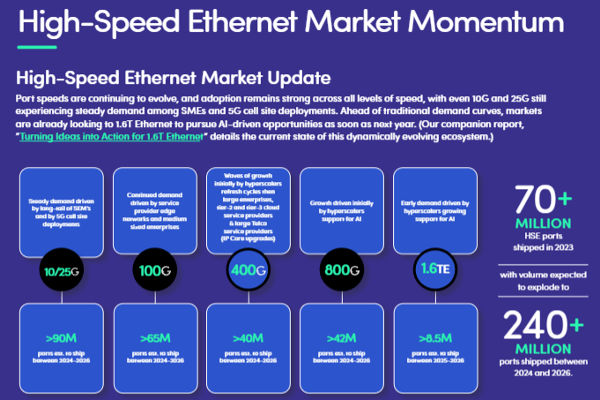Insights from more than 340 HSE engagements that Spirent supported in the previous year are included in the Spirent Impact Report, “The Future of High-Speed Ethernet Across Data Center, Telecom, and Enterprise Networking,” which provides a thorough examination of the major drivers, market effects, and future projections
Spirent Communications published its first report on the market for High-Speed Ethernet (HSE) and how developments in AI are affecting enterprise networking, telecom, and data center. It is impossible to overestimate the significance of AI since it is revolutionizing data centers and interconnects, outperforming conventional cloud apps.
Insights from more than 340 HSE engagements that Spirent supported in the previous year are included in the Spirent Impact Report, “The Future of High-Speed Ethernet Across Data Center, Telecom, and Enterprise Networking,” which provides a thorough examination of the major drivers, market effects, and future projections.
According to the report, the following are the most promising HSE trends:
- HSE port shipments continue to accelerate* – Over 70 million HSE ports were shipped by suppliers in 2023, and between 2024 and 2026, the amount is predicted to soar to over 240 million ports. As early as next year, markets are already turning to 1.6T Ethernet to explore AI-driven potential ahead of conventional demand curves.
- Ramp up of higher speeds – AI’s effects are transforming data centers and the surrounding interconnected ecosystem, necessitating network re-architecture to meet new performance and scalability demands. As a result, the market will keep moving quickly toward 400/800G and higher.
- AI fabric requires new testing approaches – Test cases that are set up to create AI workloads using actual servers are necessary for AI data center performance testing, which is a very costly endeavor. As a result, novel, affordable methods that mimic actual xPU workload traffic are being utilized to stress test AI data center networking.
Businesses are not waiting for future advancements to advance, and telecom operators are abandoning conventional playbooks to meet customers where they are in ambitious deployment cycles, even as hyperscalers migrate to 800G. Important revelations include:
- The need for speed – According to the report, 1.6T Ethernet will soon be added to 800G, which is still gaining popularity, in an attempt to address immediate demands as AI models become larger and more complicated, demanding more speed and bandwidth.
- AI inference: edge capacity will grow – Large volumes of AI traffic will be at the edge, necessitating early access and transport network capacity increases. According to early projections, edge locations may need more capacity; far-edge sites might need speed grade improvements of 25–50 G, mid-edge sites might need 100–200 G, and near-edge sites might need 400 G, with a faster refresh cycle of 800 G.
- RoCEv2 in back-end data center – By enabling direct memory access between devices via the Ethernet, Remote Direct Memory Access over Converged Ethernet (RoCEv2) is a critical component that makes high-performance, low-latency networking possible. The expanding use of RoCEv2 for AI interconnect fabrics in back-end data centers is highlighted in the report.
Key Comments Stating About The Spirent Impact Report
“As the market focuses on the power and promise of AI, there is tremendous pressure to move faster, push the boundaries of speed, and relentlessly pursue every competitive edge available in the market,” says Aniket Khosla, Vice President of Wireline Product Management at Spirent. “AI is driving an inflection point in the market and there is strong demand to understand and get ahead of the trends driving this.”
“As an independent vendor that both service providers and network equipment manufacturers (NEMs) rely on to validate cutting edge Ethernet technology and new infrastructure, Spirent has a unique perspective on the market. Our new report highlights the pace of innovation in the HSE market, AI’s data deluge pushing changes to Ethernet, and steps the industry is taking to meet the resulting challenges,” explains Khosla.
To Download The Spirent Impact Report; The Future of High-Speed Ethernet Across Data Center, Telecom, and Enterprise Networking



